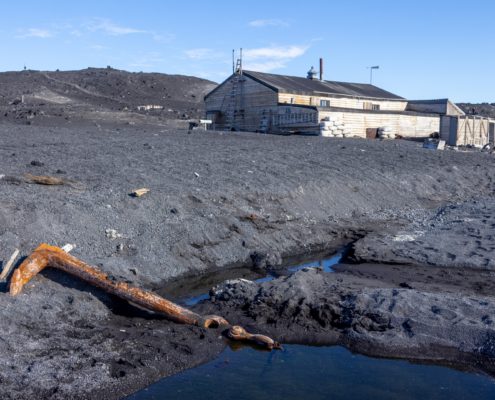Historic Antarctic Artefacts Discovered
Aurora’s second anchor with Scott’s ‘Terra Nova’ hut in the background. © Antarctica New Zealand/Anthony Powell
The discovery of historic Antarctic artefacts at Cape Evans is one of the highlights of the season for the Trust. The historic items, left behind from expeditions of the heroic age, were made visible to the conservation team due to the lack of winter snow accumulation and high snowmelt. Items included a dog hospital, mutton carcasses, Aurora’s second anchor (still with the shackles attached) and a pick axe.
The items are located around Scott’s Terra Nova hut at Cape Evans – the iconic base associated with Captain Robert Falcon Scott’s British Antarctic Expedition (1910– 1913) and his ill-fated expedition to the Geographic South Pole
Programme Manager Al Fastier says these sightings are really important, as the objects either weren’t recorded or hadn’t been seen for decades. Al was the first person to come across the mutton carcasses, still wrapped in muslin, after taking a routine walk to inspect the site at the start of the season. “We’re learning more about the hut and the activities that took place around it and we’re just getting to see things that haven’t been seen in a very long time.
The mutton would have been picked up in New Zealand on the way to Antarctica by either Scott’s British Antarctic Expedition (1910-1913) or Shackleton’s Ross Sea party of the Imperial Trans-Antarctic Expedition (1914-1917) and then stored in the snow cave.
While Al has been visiting the site since 1987, he was fascinated to see the mutton carcasses for the first time. The carcasses were recorded in the Cape Evans conservation and archaeological plans of the site and known to be in an ice cave. “I love my job and am always amazed that I keep on learning and seeing more after visiting the sites so many times,” says Al.
A second ice cave has also revealed the finds of a scientific hardwood bench that was used for gravity measurements. This had been partly exposed in previous seasons but this was the first time the Trust’s teams had seen it fully exposed. Scientists were part of the early explorers’ expedition teams and undertook significant science, including some of the earliest advances in the study of earth sciences, meteorology and biology, which is still important to scientific research today.
Conservator Jane Hamill documents the dog hospital artefacts. © Antarctica New Zealand/Anthony Powell
Al says the dog hospital is a particularly interesting find, with the remains of small stretchers made out of Venesta cases and bamboo. He believes the stretchers were used to transport injured dogs around the site and the dedicated dog handlers would have worked there. Archaeologists mapped out the area in the 1980 and 90s. While they identified many items, mapping did not reveal the full extent of these finds, making this season’s discovery significant. These new finds provide an opportunity to learn about the expeditions.
The Aurora’s second anchor, which is on of two (the other is exposed most seasons) is typically buried under snow and ice and it is rare to sight part of it let alone the whole anchor. Al says the position of the anchor on the beach shows the enormous determination and strength of those who dragged it ashore to anchor the ship. The pick axe revealed on the southern axis of the site would have belonged to one of the expeditions, says Al.
“Explorers would have had a range of tools. Potentially they were chipping away at ice to get water but snowfall might have caused them to lose it.”
Antarctic Heritage Trust have formally recorded the location of these artefacts, and will follow professional best practice in dealing with them in the future. Artefacts in the environs are individually assessed for any emergency stabilisation needs, but typically are left in situ as part of the historical context of the site.
Scott’s Terra Nova hut at the Cape Evans site houses over 11,000 historic artefacts, all conserved by the Trust as part of the Ross Sea Heritage Restoration Project.




